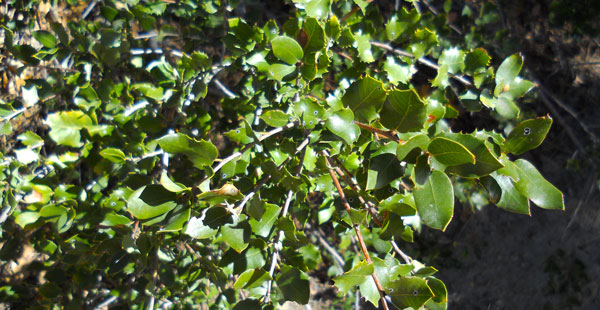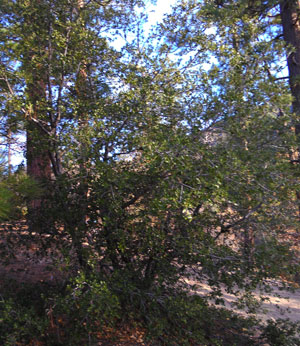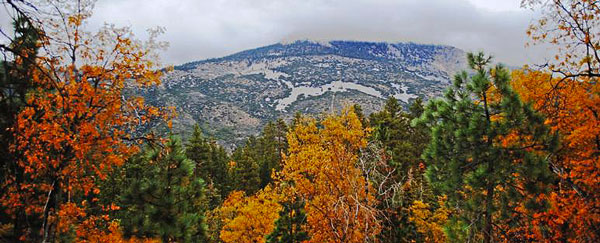“You know everything, you’re a teacher!”
In my 15+ years of teaching, I have heard that too many times to count. Know everything? No way…just the other day my knowledge came into question.
I was tagging along with a student group hiking out to Jenks Lake. The instructor was stopping every so often to show his students the wonders of the forest: lichen on a tree, the view of San Gorgonio, an impressive pine cone. Then he paused to point out one particular tree.
“I call this one a canyon oak”
the field instructor says as I gingerly step around this group of 11 year olds to investigate. Huh? A canyon oak? I jot this name down on my clip board. Is that what it’s really called? I’ve seen that plant a million times before. We have huge black oak trees here in the San Bernardino National Forest, but I can’t say with confidence that this plant is really an oak tree.
An hour or so later I left this group at Jenks Lake and hiked back, anxious to take a closer look at this “oak” tree. You know what I did, right there in the middle of the San Bernardino National Forest? Consulted my “brain” er, smartphone. And…it was a canyon oak, or more specifically, a Canyon Live Oak…

The Canyon Live Oak
 The Canyon Live Oak is an evergreen oak, meaning it keeps its green leaves all year. I’ve always thought this plant looked a lot like Christmas holly. Apparently, it can grow to be a large tree or, like I saw, stay smaller like a shrub. The leaves of this tree are what really intrigue me. They are glossy and dark on top, but gray and dull on the underside. The edges curve under just ever so slightly; some having smooth edges and others are prickly to the touch. Smooth leaves are older and spiny leaves are young, but both types are present on many trees.
The Canyon Live Oak is an evergreen oak, meaning it keeps its green leaves all year. I’ve always thought this plant looked a lot like Christmas holly. Apparently, it can grow to be a large tree or, like I saw, stay smaller like a shrub. The leaves of this tree are what really intrigue me. They are glossy and dark on top, but gray and dull on the underside. The edges curve under just ever so slightly; some having smooth edges and others are prickly to the touch. Smooth leaves are older and spiny leaves are young, but both types are present on many trees.
This California Native produces flowers at about 20 years of age; there are both male (these are called catkins) and female flowers on the oak, making the Canyon Live Oak monoecious. These flowers are scattered throughout the crown to limit self fertilization which can weaken the species and a good, strong wind is necessary to spread these and help pollinate.
 The female flowers become little nuts that wear turban-like hats; the acorn! Believe it or not, it does take a full 18 months for these acorns to mature. Most Canyon Live Oaks will produce acorns annually, but it is believed that the amount of acorns depends on the moisture the plant received two years prior. On average, one mature and full size tree can produce 150 pounds of acorns. Also, these oaks have a “mast” season every two to six years, when the plant produces massive amounts of acorns!
The female flowers become little nuts that wear turban-like hats; the acorn! Believe it or not, it does take a full 18 months for these acorns to mature. Most Canyon Live Oaks will produce acorns annually, but it is believed that the amount of acorns depends on the moisture the plant received two years prior. On average, one mature and full size tree can produce 150 pounds of acorns. Also, these oaks have a “mast” season every two to six years, when the plant produces massive amounts of acorns!
Canyon Live Oaks are a good habitat for many animals; they provide a place to perch for birds and a safe place to hide for other animals. The acorn woodpecker is one bird that relies heavily on the acorns from the Canyon Live Oaks. These birds, along with squirrels and chipmunks, help to distribute the acorns for future plants to grow. Deer LOVE these acorns as well. This tree attracts prey which then attracts predators, helping keep the animal population in balance. Good job oak tree!
 The thin bark of the oak is smooth and whitish when young, checked and gray with age (sounds like us humans). Their root system is directly related to the soil; in coarse soils they can have a pronounced taproot, but in rocky soils the roots are dense and spreading. Pretty cool how they adapt to their surroundings! Canyon Live Oaks can grow in many environments, but are found predominantly on the west coast.
The thin bark of the oak is smooth and whitish when young, checked and gray with age (sounds like us humans). Their root system is directly related to the soil; in coarse soils they can have a pronounced taproot, but in rocky soils the roots are dense and spreading. Pretty cool how they adapt to their surroundings! Canyon Live Oaks can grow in many environments, but are found predominantly on the west coast.
Black Oak: The Larger Cousin

It’s hard to believe, but there are over 500 species of oaks. The larger, more majestic oak in our local forest is called the Black Oak. These trees differ from the Canyon Live Oak in that the Black Oak is deciduous; meaning that it grows new leaves in the spring and then sheds them come winter. Walking through our forest in the fall is definitely magical with all of the golden orange hues created by the fading Black Oak leaves.
It’s easy to bypass the Canyon Live Oak when there are other, more prominent trees to grab our attention. But sometimes you just want to know more about the little guy. Canyon Live Oak, you may be “the other oak in our forest”, but I’m glad we had our moment together. Your simple beauty left a lasting impression on this outdoor educator.

At High Trails Outdoor Science School, we literally force our instructors to write about elementary outdoor education, teaching outside, learning outside, our dirty classroom (the forest…gosh), environmental science, outdoor science, and all other tree hugging student and kid loving things that keep us engaged, passionate, driven, loving our job, digging our life, and spreading the word to anyone whose attention we can hold for long enough to actually make it through reading this entire sentence. Whew…. www.dirtyclassroom.com

Comments are closed.